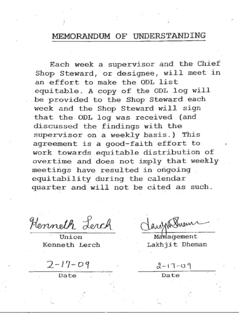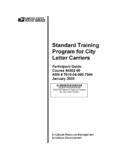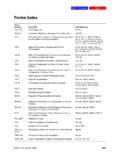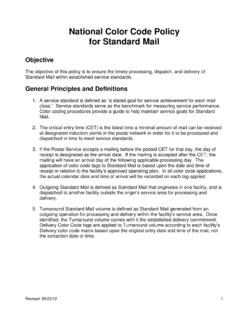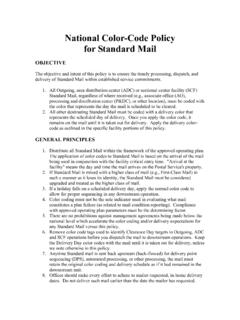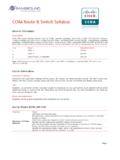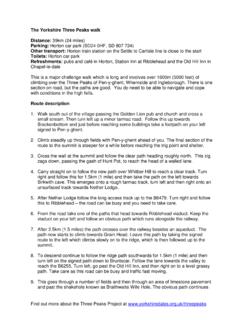Transcription of LETTER CARRIER DUTIES Daily Physical Operations Sorting ...
1 DETAILED DESCRIPTION OF CARRIER DUTIES TO PROVIDE MEDICAL PERSONELL TO ASSIST WITH COMPLETION OF OWCP FORMS LETTER CARRIER DUTIES Daily Physical Operations Sorting / Loading A LETTER CARRIER works five days a week (or six, with overtime). A Daily tour of duty consists of eight hours with the possibility of working up to four hours overtime. Overtime cannot be refused when directed / ordered by Management. LETTER Carriers are required to stand at their Sorting case inserting the mail by street and address for approximately three hours a day. The balance of an eight hour tour is spent on the street. Sorting of LETTER mail requires the CARRIER to use the right arm up and down, left and right in order to insert the mail piece into the proper segment on one of the shelves of the Sorting case.
2 In the left hand the CARRIER holds 4-6 inches of letters. For magazines, circulars and large envelopes the CARRIER is required to cradle a minimum of six inches of mail with the left arm. The CARRIER inserts the magazines etc. in the same manner as LETTER size mail. A typical Sorting case configuration can consist of 1 to 3 Sorting cases, each having four or five shelves with 40 one inch separations marked with 1 or 2 addresses. Approximately eighteen inches of the upper filing is above eye level. The main Sorting case rests on a base that provides a ledge surface approximately 2 X 4 feet and is about 32 inches high. With configurations of more than one Sorting case the CARRIER is required to twist, turn, bend and / or stretch while inserting the mail into the designated separation.
3 The LETTER size mail is at or brought to the Carriers case in plastic trays 2 feet in length. The CARRIER grasps the tray at the ends and flips it over onto the ledge. He/she then grasps a full handful with his or her left and begins the insertion process. Magazine, etc. are usually on the floor next to the adjacent to the Sorting case area. That mail is in tubs approximately 12 and 18 wide. The CARRIER is required to lift the tub onto the ledge and then lift the mail out onto the ledge. At that point the CARRIER would then cradle a minimum of six inches in the left arm and begin the Sorting process as with the letters. The weight of the magazine tub and LETTER trays is dependant upon the type and size of the mail. All Carriers are required to lift mail not exceeding 70 lbs.
4 Depending on the delivery route, volume of mail, type of mail the above procedures are performed until all mail for that day s delivery is in the Sorting cases. When all the mail is cased the CARRIER then begins the street preparation. The mail in the Sorting cases is removed from the case in the order of delivery and placed in trays 2 feel in length. Full trays can weigh up to 50 or more pounds. The number of trays varies per delivery route. As each tray is filled the CARRIER must then lift it and place it into a hamper which also involve bending at the waist when putting it into the hamper. When the Carriers has filled the hamper(s) they are wheeled out to his/her delivery vehicle and loaded into the truck. Normally, it is necessary to push the loaded hampers down a ramp to the parking area.
5 The loading operation involves the lifting, pushing and pulling of the 50+ lb. trays, with some of the lifting being performed from awkward positions. In addition, Carriers also load and deliver parcels, not to exceed 70 lbs, which must also be handled and loaded into the delivery vehicle and finally carried to the customers door. Daily Physical Operations Delivery The actual delivering of the mail also varies depending on the particular route; the following is a general description. A CARRIER is required to carry a satchel on his/her back loaded with up to 35 lbs. of mail. At times, parcels are placed into the satchel to fill it up or to weigh 35 lbs. In the course of delivery, he/she must at times bend down to low door slots or stretch over obstacles to place the mail in a box while the loaded satchel is on his/her back.
6 Bad weather - rain, ice or snow - also creates a hazard of slips and falls. On routes having curbside delivery, the CARRIER is constantly twisting and turning in the vehicle to deliver the mail. Physical stress is continually being placed on the CARRIER 's back, spine, shoulders, neck and legs by walking five to eight miles or more a day over variable terrain and in all types of weather. Technician Carriers, T-6 s work a five day swing on five different routes, getting in and out of five different vehicles. On park and loop routes, which consist of parking and "looping" 1 or 2 streets at a time by going up one side of the street and down the other, returning to the park point to pick up more mail and small parcels for delivery or moving to another park point. The delivery separation is put into a CARRIER satchel, which weighs 5 lbs (empty), for delivery.
7 The satchel is carried on the shoulder supported only by the shoulder strap, which allows the satchel to swing freely. The weight of the mail slowly decreases as it is delivered. Delivering mail consists of walking, walking up and down stairs, walking on uneven terrain, twisting, turning, bending, reaching, reaching above the shoulder and stooping. Some of the delivery separations have a larger saturation of deliveries, steps and mail than others. This is done for approximately 5 to 7 hours in all types of weather conditions. LETTER carriers tend to lean to the opposite side of the satchel to balance the weight, which subjects the body to abnormal posture. The heavier the satchel the more force needed to compensate for the weight. As a LETTER CARRIER , there are many Physical DUTIES and requirements.
8 The day begins routing letters into a 4 or 5 shelf "L" shaped case, with up to 360 vertical separations, which are in route delivery sequence. This entails approximately to hours of continuous standing, twisting, turning, and reaching over the shoulder. A CARRIER is also required to lift, from the floor, trays of unsorted mail weighing between 17 and 29 pounds. The handbook titled City Delivery Carriers'-- DUTIES and Responsibilities, states that "the accurate and speedy routing of mail is one of the most important DUTIES of a CARRIER ; you must be proficient at this task". After routing letters, "flat-size" mail (magazine or mail too large for LETTER casing) is routed into a 4 or 5 shelf "L" shaped mail case, with up to 360 vertical separations, which are in route delivery sequence.
9 This is done for approximately .5 to 2 hours, this function also requires continuous reaching over the shoulder, bending, standing, stooping, twisting and lifting from ounces to 2 lbs. Parcels for the route are then taken from a wheeled hamper which stands 2 ft. 4 inches high. This consists of constant bending, reaching and lifting parcels weighing from ounces up to 70 lbs. The mail is then withdrawn from the LETTER and flat cases and bundled into separations for delivery. This entails standing, twisting, turning, bending and reaching. The letters, flats and small parcels are then put into lbs plastic trays, the trays are placed into a wheeled "bungie" hamper which stands 3 ft. high. The wood bottom of the hamper is supported by bungie cords, which allows the hamper bottom to fall and rise as the weight is placed in or taken out.
10 An average route, on an average day, has approximately 4 full plastic trays of mail (an average tray of mail weighs approximately 50 lbs) and 3 or 4 large parcels weighing up to 70 lbs. The hamper is then wheeled to the vehicle for loading. In many cases the hamper must be pushed or pulled down an inclined ramp to reach the vehicle. The trays and parcels are then lifted out of the hamper and loaded into the vehicle. This consists of bending, lifting, twisting, turning and stooping. DELIVERY DUTIES The delivery part of the day then begins. The routes are park and loop routes, which consists of parking and "looping" 1 or 2 hundred blocks at a time by going up one side block and down the other returning to the park point to pick up more mail and small parcel for deliveryor moving to another park point.
